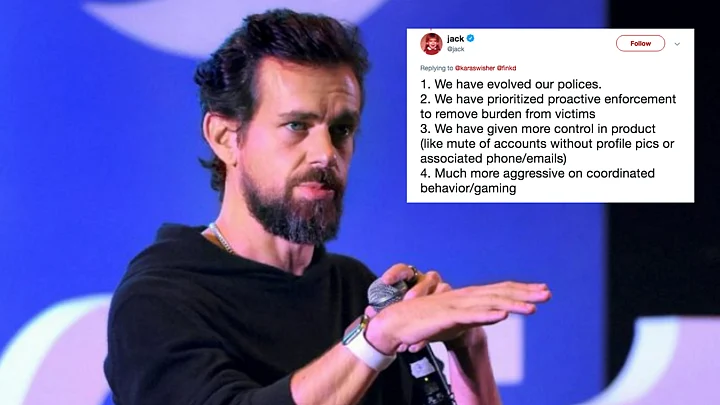Twitter CEO Jack Dorsey did a first of its kind live Twitter interview with ReCode co-founder Kara Swisher on Tuesday, 12 February. The interview was announced a few days ago, with Dorsey hinting that this might be turned into a feature. People were asked to follow the conversation using #KaraJack.
Expectedly, chaos ensued during the conversation as everyone had the liberty to jump in. Swisher also threw some tough questions at Jack – from tech responsibility, the platform allegedly tolerating trolls, Dorsey’s pick of the most influential user and what Twitter was doing to protect users.
The Twitter chief obliged to most questions, although the surge of replies and threads kept piling on, making the interview hard to follow.
With Twitter’s character limit, the interview was also vague at times.
‘Why Aren’t You Moving Faster?’
The interview began with Swisher putting users’ concerns first. Why don’t tech companies move faster when it comes to fixing what is broke, she asked Dorsey.
‘C’ Grade on Tech Responsibility
When asked how he would grade the Silicon Valley (referring to other tech giants, since all are based in the San Francisco city) and Twitter in particular on handling tech responsibility, Jack graded his organisation a ‘C’. He asserted that the company had put “most of the burden” on “victims of abuse” and called it a “huge fail.”
How Twitter is Changing
When Swisher asked him what was being changed on Twitter to ensure healthy conversations, Dorsey said that promoting health is the priority and that the micro-blogging website is evolving its policies “to address the issues we see today.”
On Threats to Health of Digital Conversations
Dorsey insisted that Twitter is “focused on understanding” what conversational health means and admitted that it had seen a ton of threats.
How Much Downside is Twitter Willing to Tolerate?
When asked on how much downside Dorsey was willing to take to balance the good that Twitter can provide, he said that the company has to think very deeply about this.
He also accepted that most cyber abuse takes place in replies, mentions, searches, and trends.
What Is The ‘Illness’ Twitter is Treating?
Swisher asked the Twitter CEO what is the illness that he was trying to treat? In a metaphor referring to the micro-blogging website’s issues, she pointed out that a disease can’t be treated without knowing enough about the disease itself. The interviewer also questioned Dorsey if he was the one who had created the virus.
Dorsey responded that Twitter was focused majorly on off-platform ramifications.
What Are Offline Ramifications?
To this, Dorsey said it is what people do offline with what they see online. He said Doxxing (when an individual’s personal information is published online without consent) is an example that threatens physical safety. So does coordinated harassment over something said online.
He also admitted that tech giants have not focused enough to ensure the safety of users.
“I mean we have to consider first and foremost what online activity does to impact physical safety, as a way to prioritise our efforts.”Jack Dorsey, CEO, Twitter
Three Things Twitter Has Done to Make Users Feel Safe
However, when asked repeatedly how Twitter plans to do it, Jack said that the company has to look at how the product works. Although he listed a few measures after Swisher grilled him for specifics, Dorsey’s answers were largely vague.
Dorsey Feels ‘Terrible’ About People Taking Twitter Breaks
Jack said he felt “terrible” when people take a break from Twitter, and he wants people to walk away from the platform feeling like they have learnt something, not because "they don’t feel good."
Where Does Twitter Draw The Line?
Dorsey was also asked if Twitter will ever consider suspending a public figure, with Swisher citing the example of US President Donald Trump, whose tweets are often considered to be offensive and uninformative.
To this, Dorsey said that Twitter holds all accounts to the same terms of service. He, however, admitted that the newsworthy/public interest clause that gives advantages to public figures is actually controversial.
He also added that Twitter’s services don’t depend on a single person or account.
On Preventing Interference Ahead of Elections
Since social media was the catalyst that enabled alleged Russian meddling in 2016 US presidential elections, Dorsey was asked what measures were being taken to prevent this from happening again ahead of elections in several countries.
He responded, saying that he expects a lot more coordination between the governments and social media platforms.
When asked about the single-largest development towards this, Dorsey said Twitter has tried to clamp down automation and coordinated campaigns, and partnered with “government agencies to improve communication around threats.”
Who is Dorsey’s Pick For Most ‘Exciting Influential’ Person on Twitter
On a lighter note, Swisher asked Dorsey who was the most “exciting influential" person on Twitter.
And the answer was – Elon Musk.
(At The Quint, we question everything. Play an active role in shaping our journalism by becoming a member today.)
